Abstract
Cytotoxic chemicals have in common the ability to act specifically on cells in cycle. Bacteria are more sensitive in the exponential growth phase than when growing slowly in media. Similar observations have been made on a variety of systems ranging from bacteria, yeast, higher plants and invertebrates to vertebrates including primates. The embryo and fetus are highly susceptible to cytotoxic agents because they have continuous groups of cells in the growth phase. Acutely toxic doses may cause cellular death and result in developmental defects or fetal death. Cytotoxic agents can be grouped as alkylating agents, electrophilic reactants, antimetabolites, intercalating agents, amino acid antagonists, spindle poisons, and an additional group of chemicals which covalently bind to DNA. These cytotoxic groups of chemicals may also be mutagenic by interacting with DNA to produce changes in sequences of nucleotides resulting in heritable defects either in a somatic cell line or in a germinal cell line. The mechanisms of chemical-induced teratogenicity and mutagenicity are similar. This commonality is further discussed in the text.
Full text
PDF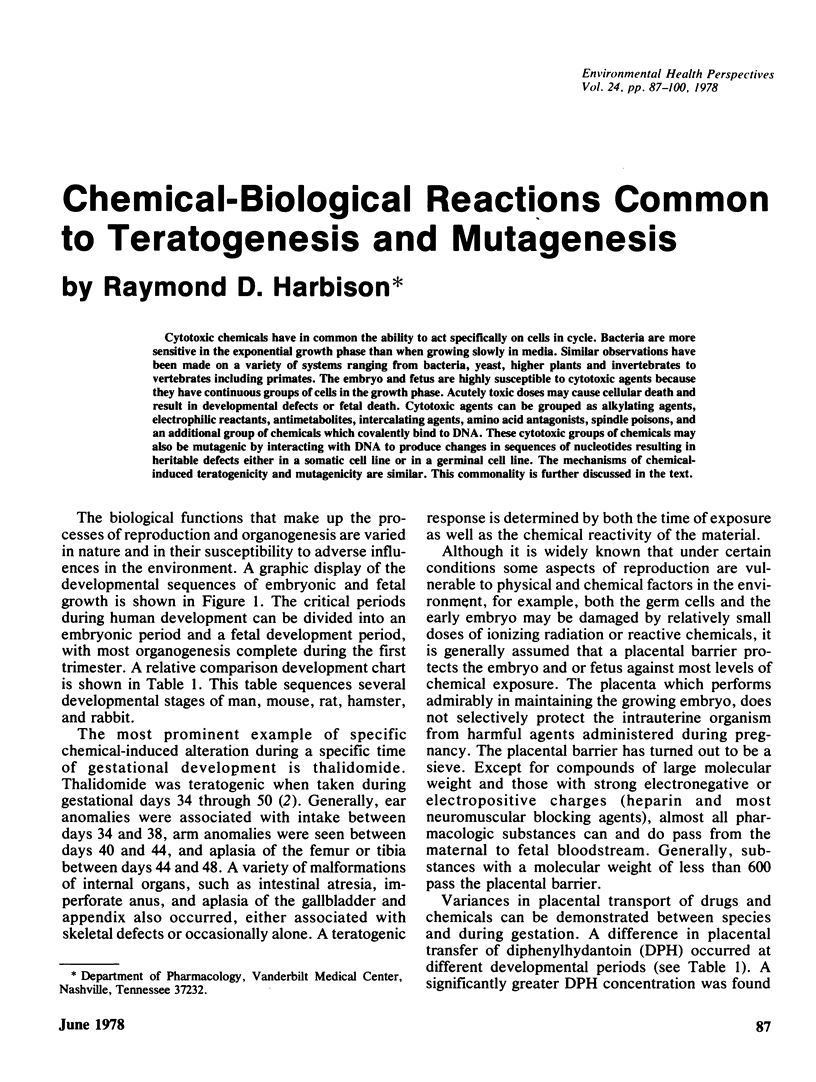
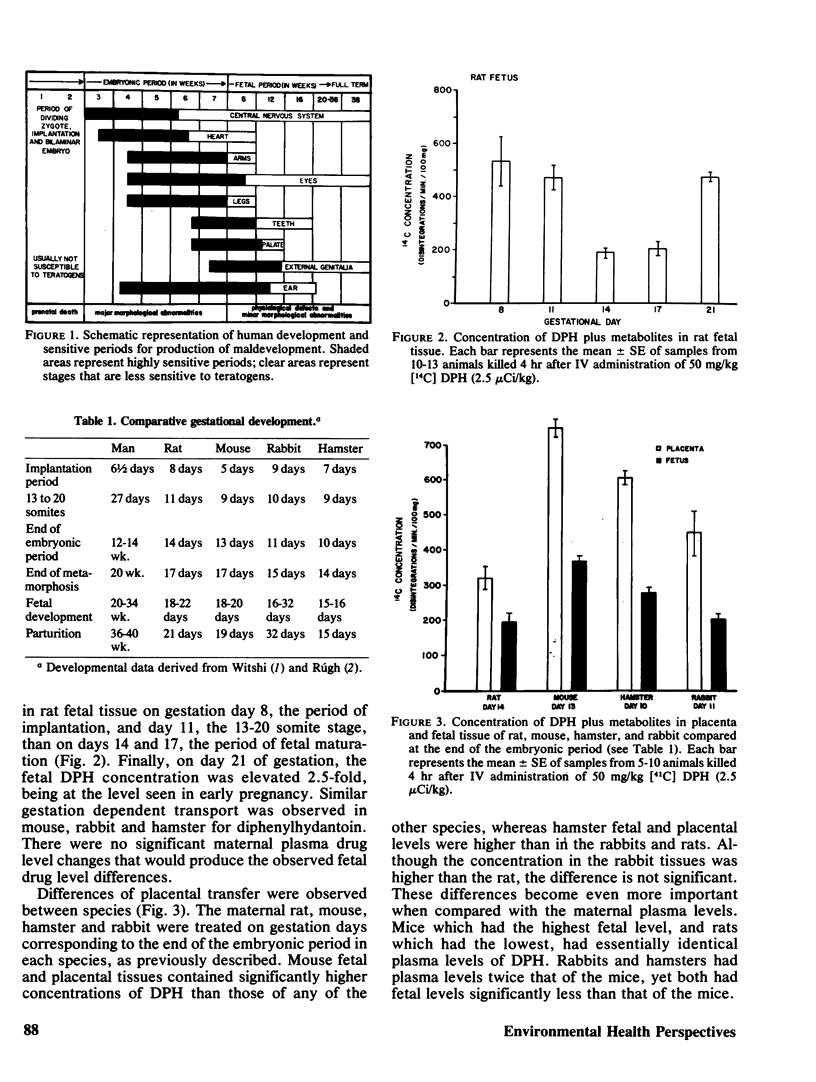
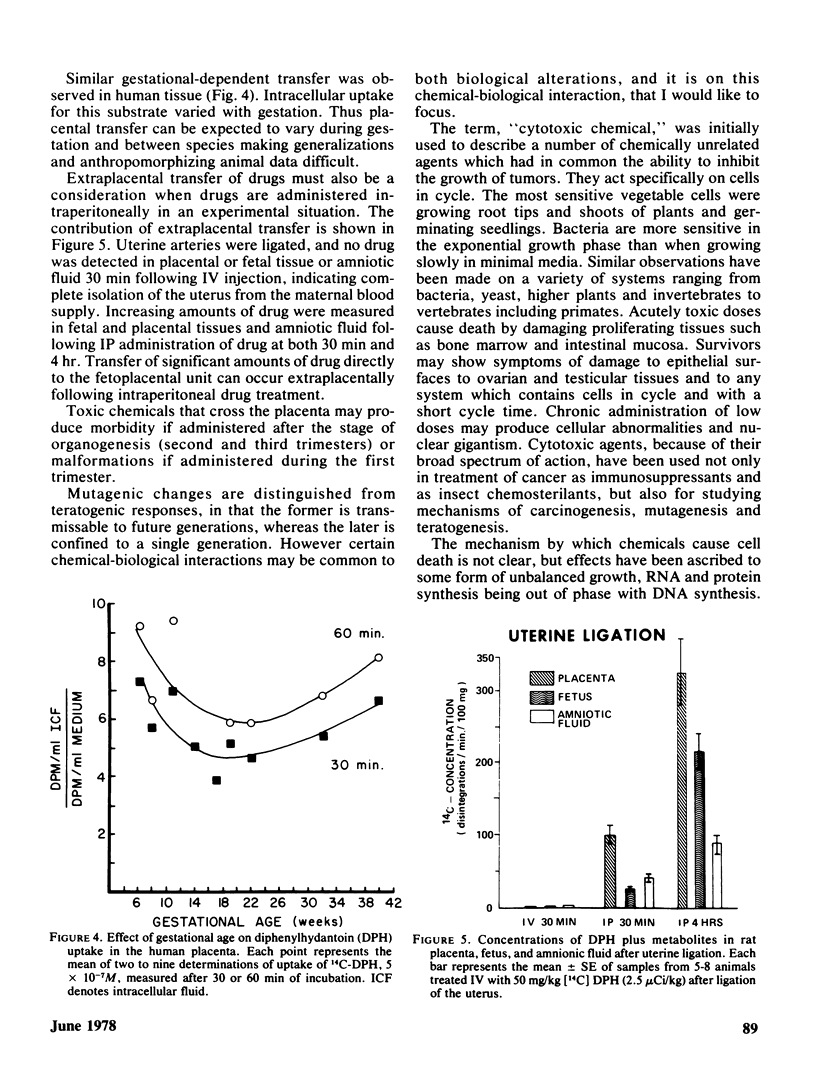
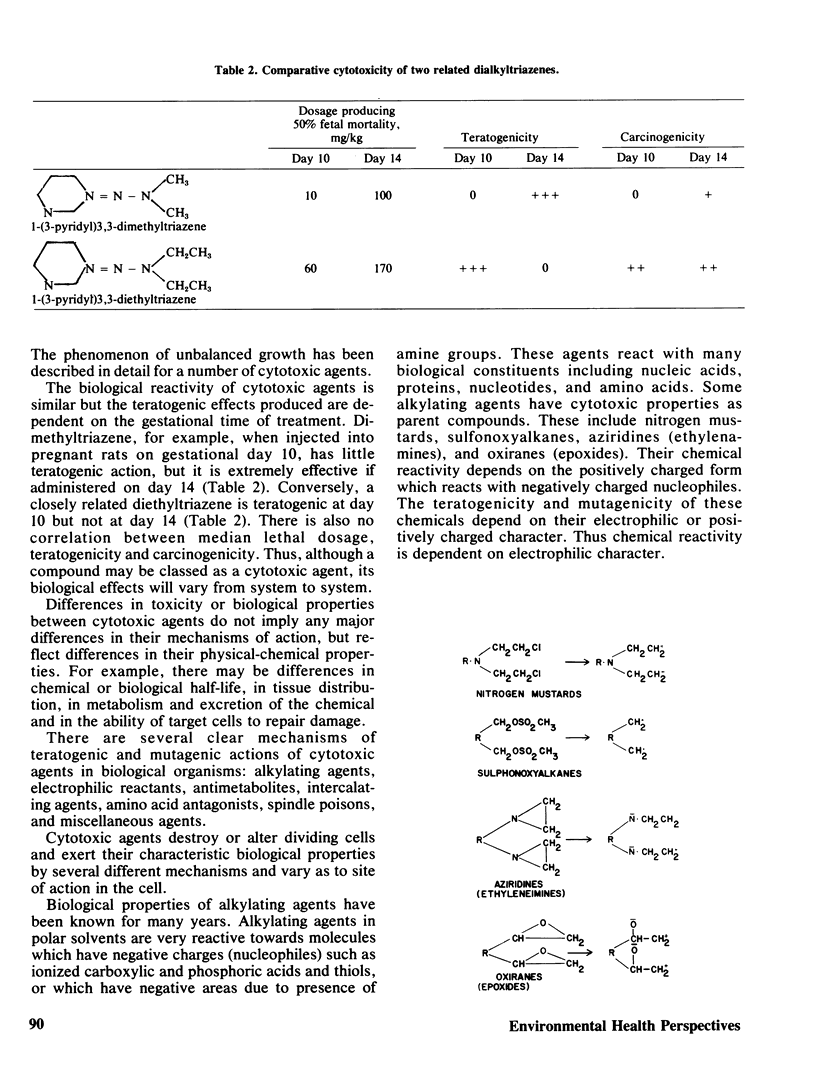
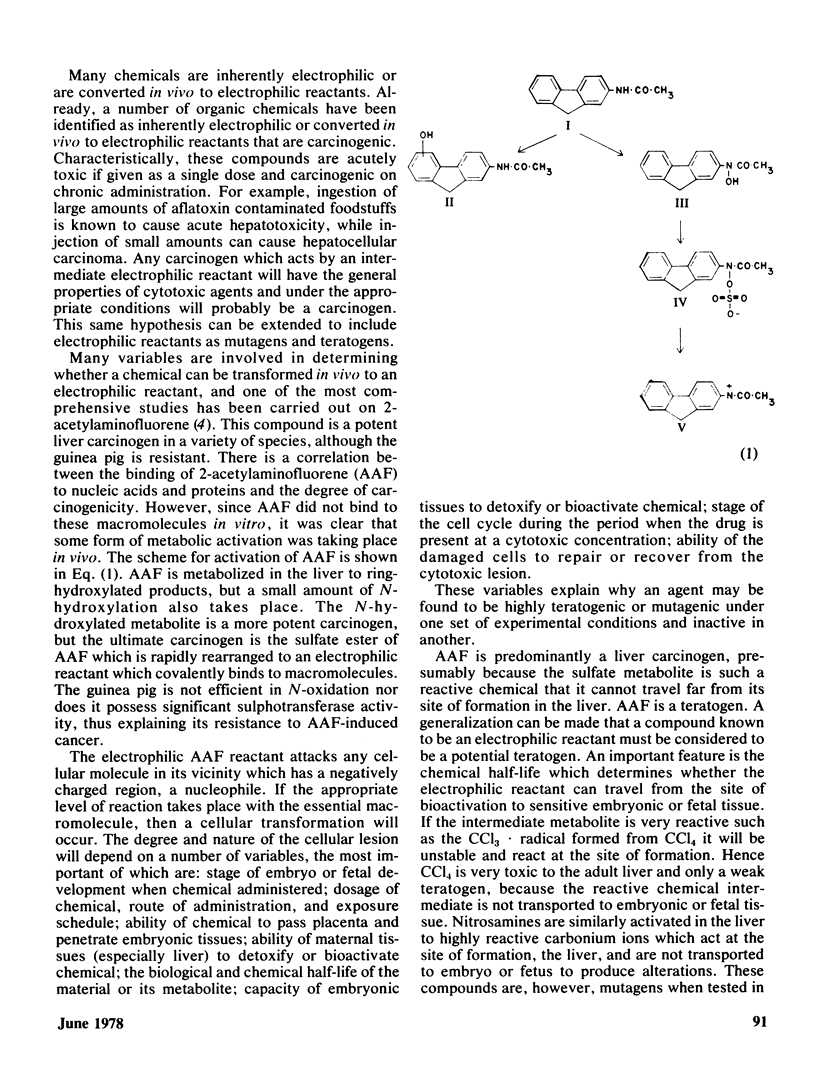


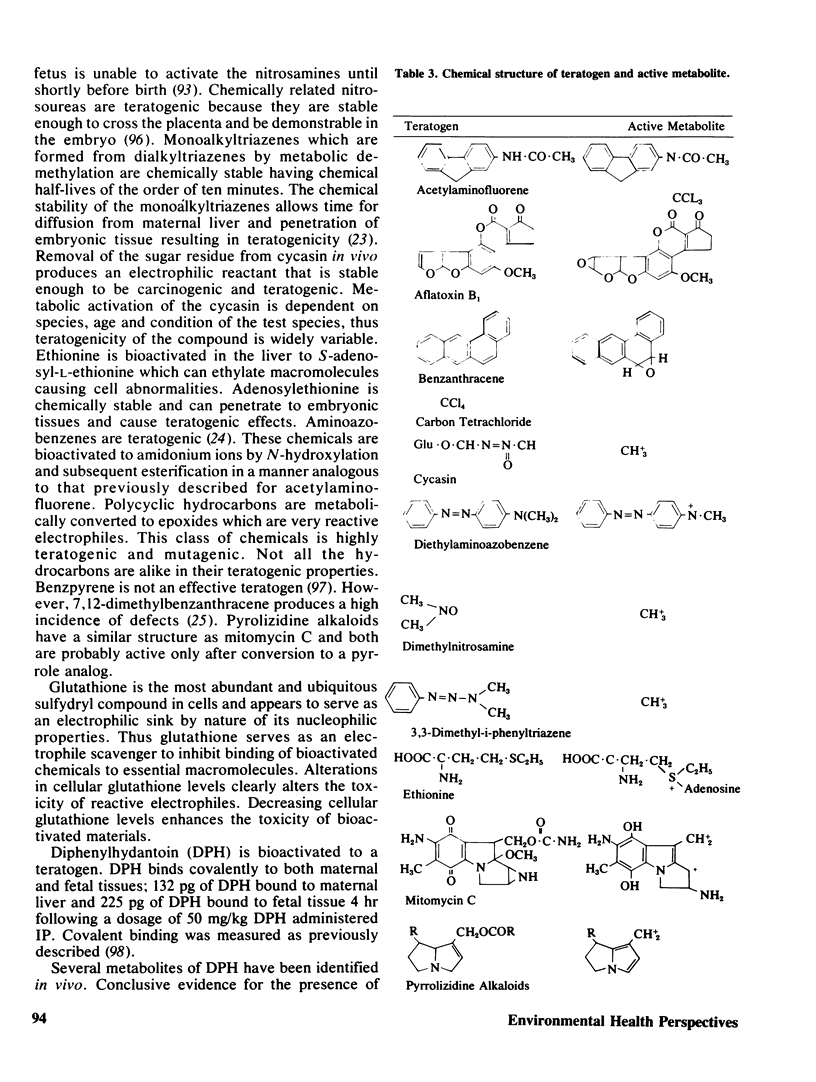
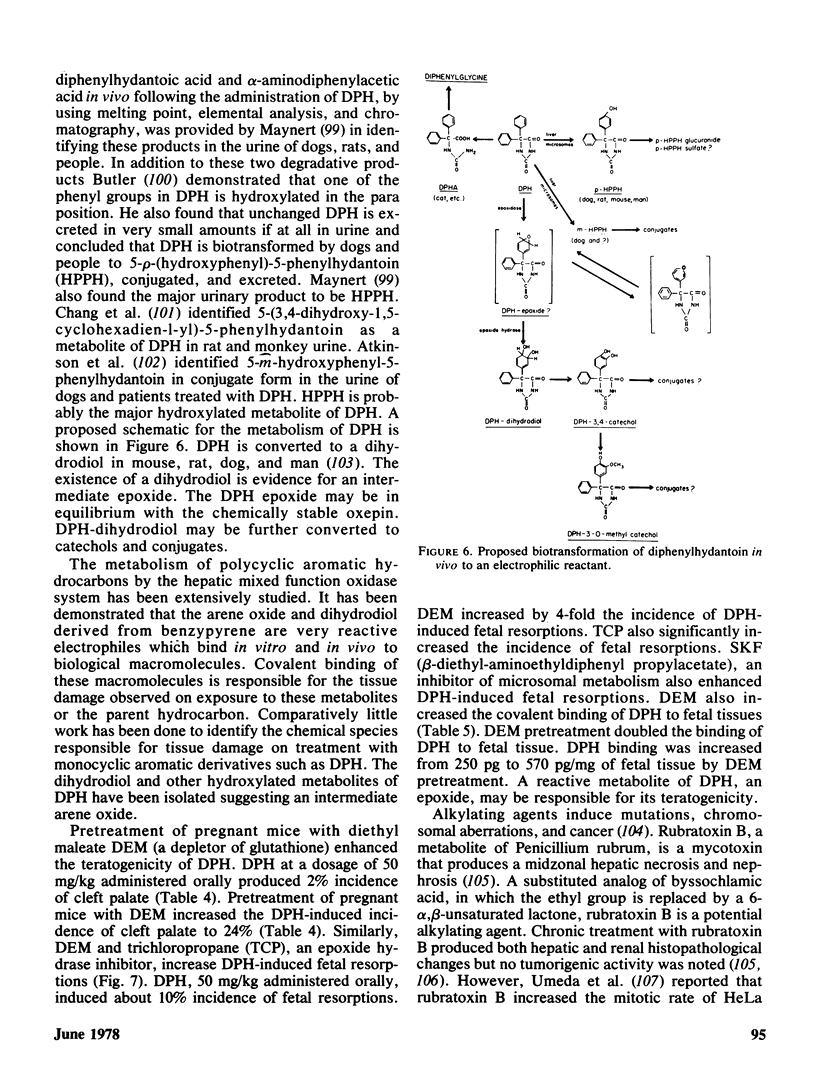

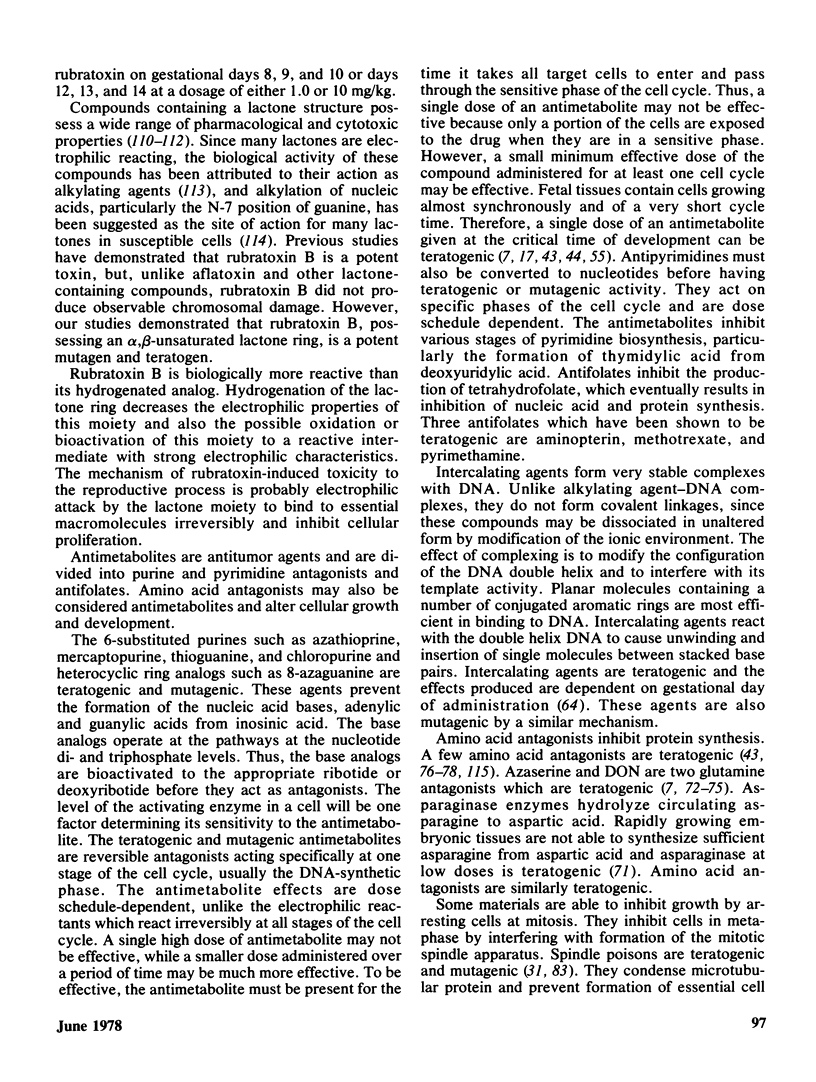
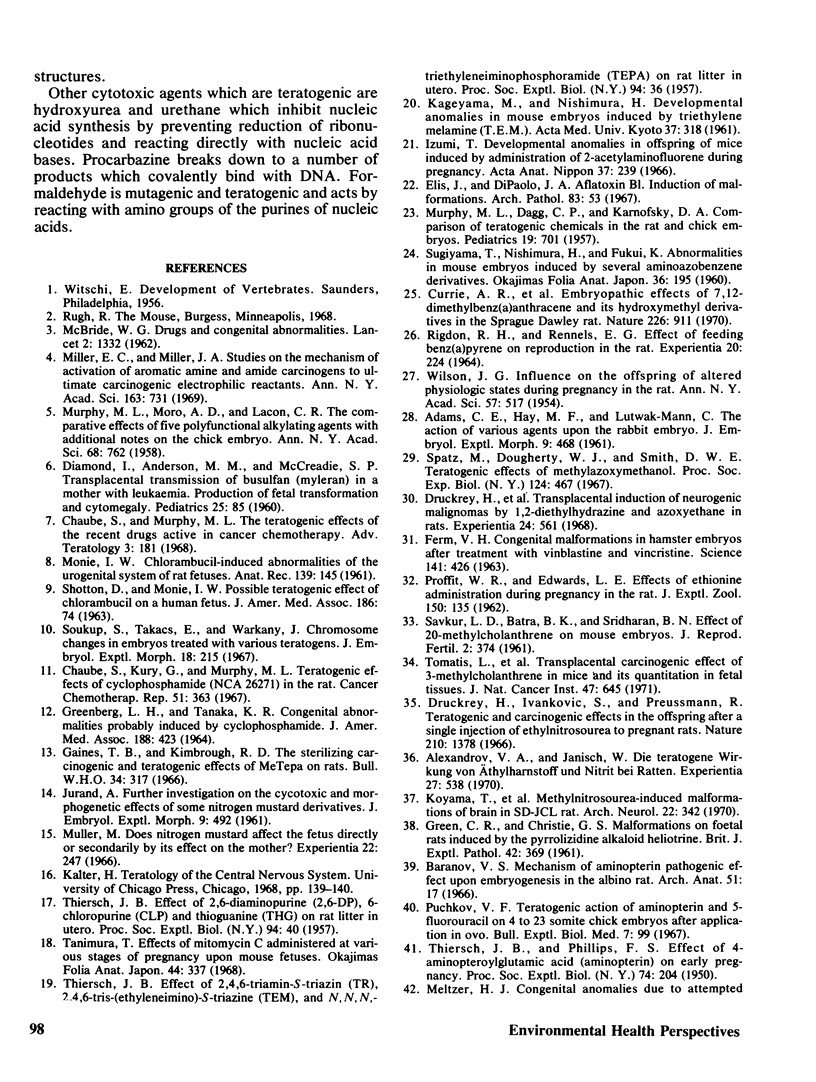
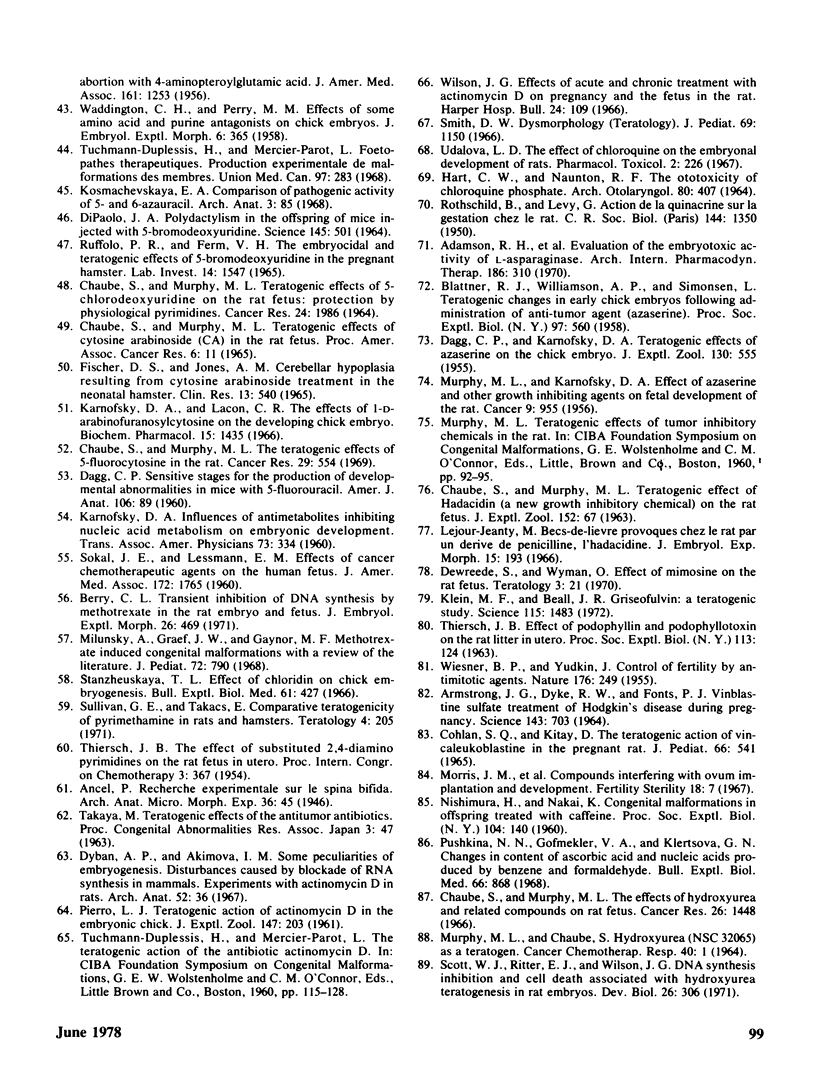
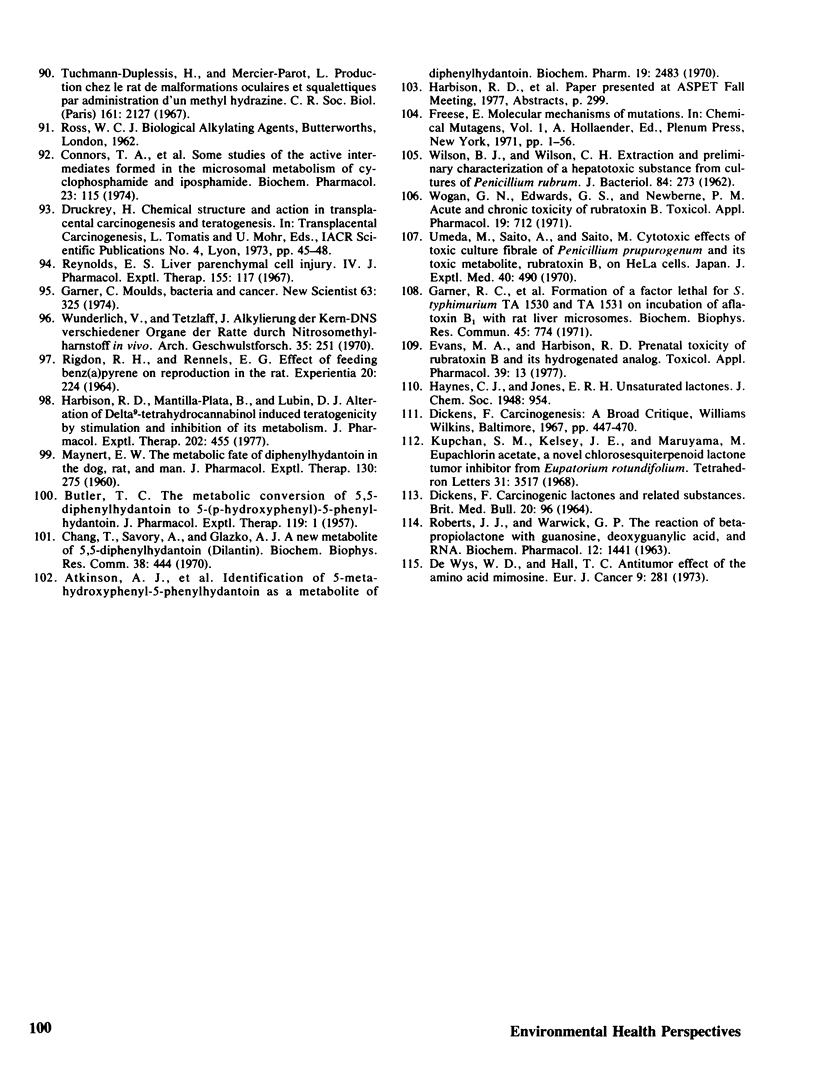
Selected References
These references are in PubMed. This may not be the complete list of references from this article.
- ADAMS C. E., HAY M. F., LUTWAK-MANN C. The action of various agents upon the rabbit embryo. J Embryol Exp Morphol. 1961 Sep;9:468–491. [PubMed] [Google Scholar]
- ARMSTRONG J. G., DYKE R. W., FOUTS P. J. VINBLASTINE SULFATE TREATMENT OF HODGKIN'S DISEASE DURING A PREGNANCY. Science. 1964 Feb 14;143(3607):703–703. doi: 10.1126/science.143.3607.703. [DOI] [PubMed] [Google Scholar]
- Adamson R. H., Fabro S., Hahn M. A., Creech C. E., Whang-Peng J. Evaluation of the embryotoxic activity of L-asparaginase. Arch Int Pharmacodyn Ther. 1970 Aug;186(2):310–320. [PubMed] [Google Scholar]
- Alexandrov V. A., Jänisch W. Die teratogene Wirkung von Athylharnstoff und Nitrit bei Ratten. Experientia. 1971 May 15;27(5):538–539. doi: 10.1007/BF02147586. [DOI] [PubMed] [Google Scholar]
- Atkinson A. J., Jr, MacGee J., Strong J., Garteiz D., Gaffney T. E. Identification of 5-meta-hydroxyphenyl-5-phenylhydantoin as a metabolite of diphenylhydantoin. Biochem Pharmacol. 1970 Aug;19(8):2483–2491. doi: 10.1016/0006-2952(70)90274-1. [DOI] [PubMed] [Google Scholar]
- BLATTNER R. J., WILLIAMSON A. P., SIMONSEN L. Teratogenic changes in early chick embryos following administration of antitumor agent; azaserine. Proc Soc Exp Biol Med. 1958 Mar;97(3):560–564. doi: 10.3181/00379727-97-23805. [DOI] [PubMed] [Google Scholar]
- BUTLER T. C. The metabolic conversion of 5, 5-diphenyl hydantoin to 5-(p-hydroxyphenyl)-5-phenyl hydantoin. J Pharmacol Exp Ther. 1957 Jan;119(1):1–11. [PubMed] [Google Scholar]
- Berry C. L. Transient inhibition of DNA synthesis by methotrexate, in the rat embryo and foetus. J Embryol Exp Morphol. 1971 Dec;26(3):469–474. [PubMed] [Google Scholar]
- CHAUBE S., MURPHY M. L. TERATOGENIC EFFECTS OF 5-CHLORODEOXYURIDINE ON THE RAT FETUS; PROTECTION BY PHYSIOLOGICAL PYRIMIDINES. Cancer Res. 1964 Dec;24:1986–1993. [PubMed] [Google Scholar]
- COHLAN S. Q., KITAY D. THE TERATOGENIC EFFECT OF VINCALEUKOBLASTINE IN THE PREGNANT RAT. J Pediatr. 1965 Mar;66:541–544. doi: 10.1016/s0022-3476(65)80118-4. [DOI] [PubMed] [Google Scholar]
- Chang T., Savory A., Glazko A. J. A new metabolite of 5,5-diphenylhydantoin (Dilantin). Biochem Biophys Res Commun. 1970 Feb 6;38(3):444–449. doi: 10.1016/0006-291x(70)90733-3. [DOI] [PubMed] [Google Scholar]
- Chaube S., Murphy M. L. The effects of hydroxyurea and related compounds on the rat fetus. Cancer Res. 1966 Jul;26(7):1448–1457. [PubMed] [Google Scholar]
- Chaube S., Murphy M. L. The teratogenic effects of 5-fluorocytosine in the rat. Cancer Res. 1969 Mar;29(3):554–557. [PubMed] [Google Scholar]
- Connors T. A., Cox P. J., Farmer P. B., Foster A. B., Jarman M. Some studies of the active intermediates formed in the microsomal metabolism of cyclophosphamide and isophosphamide. Biochem Pharmacol. 1974 Jan 1;23(1):115–129. doi: 10.1016/0006-2952(74)90318-9. [DOI] [PubMed] [Google Scholar]
- Currie A. R., Bird C. C., Crawford A. M., Sims P. Embryopathic effects of 7,12-dimethylbenz(a)anthracene and its hydroxymethyl derivatives in the Sprague-Dawley rat. Nature. 1970 Jun 6;226(5249):911–914. doi: 10.1038/226911a0. [DOI] [PubMed] [Google Scholar]
- DAGG C. P. Sensitive stages for the production of developmental abnormalities in mice with 5-fluorouracil. Am J Anat. 1960 Mar;106:89–96. doi: 10.1002/aja.1001060202. [DOI] [PubMed] [Google Scholar]
- DICKENS F. CARCINOGENIC LACTONES AND RELATED SUBSTANCES. Br Med Bull. 1964 May;20:96–101. doi: 10.1093/oxfordjournals.bmb.a070324. [DOI] [PubMed] [Google Scholar]
- DIPAOLO J. A. POLYDACTYLISM IN THE OFFSPRING OF MICE INJECTED WITH 5-BROMODEOXYURIDINE. Science. 1964 Jul 31;145(3631):501–503. doi: 10.1126/science.145.3631.501. [DOI] [PubMed] [Google Scholar]
- DeWys W. D., Hall T. C. Anti-tumor effect of the amino acid minosine. Eur J Cancer. 1973 Apr;9(4):281–283. doi: 10.1016/0014-2964(73)90094-7. [DOI] [PubMed] [Google Scholar]
- Druckrey H., Ivankovic S., Preussmann R., Landschütz C., Stekar J., Brunner U., Schagen B. Transplacentar induction of neurogenic malignomas by 1,2-diethyl-hydrazine, azo-, and azoxy-ethane in rats. Experientia. 1968 Jun 15;24(6):561–562. doi: 10.1007/BF02153772. [DOI] [PubMed] [Google Scholar]
- Druckrey H., Ivanković S., Preussmann R. Teratogenic and carcinogenic effects in the offspring after single injection of ethylnitrosourea to pregnant rats. Nature. 1966 Jun 25;210(5043):1378–1379. doi: 10.1038/2101378a0. [DOI] [PubMed] [Google Scholar]
- Evans M. A., Harbison R. D. Prenatal toxicity of rubratoxin B and its hydrogenated analog. Toxicol Appl Pharmacol. 1977 Jan;39(1):13–22. doi: 10.1016/0041-008x(77)90172-7. [DOI] [PubMed] [Google Scholar]
- FERM V. H. Congenital malformations in hamster embryos after treatment with vinblastine and vincristine. Science. 1963 Aug 2;141(3579):426–426. doi: 10.1126/science.141.3579.426. [DOI] [PubMed] [Google Scholar]
- GREENBERG L. H., TANAKA K. R. CONGENITAL ANOMALIES PROBABLY INDUCED BY CYCLOPHOSPHAMIDE. JAMA. 1964 May 4;188:423–426. doi: 10.1001/jama.1964.03060310023005. [DOI] [PubMed] [Google Scholar]
- GREEN C. R., CHRISTIE G. S. Malformations in foetal rats induced by the pyrrolizidine alkaloid, heliotrine. Br J Exp Pathol. 1961 Aug;42:369–378. [PMC free article] [PubMed] [Google Scholar]
- Gaines T. B., Kimbrough R. D. The sterilizing, carcinogenic and teratogenic effects of metepa in rats. Bull World Health Organ. 1966;34(2):317–320. [PMC free article] [PubMed] [Google Scholar]
- Garner R. C., Miller E. C., Miller J. A., Garner J. V., Hanson R. S. Formation of a factor lethal for S. typhimurium TA1530 and TA1531 on incubation of aflatoxin B 1 with rat liver microsomes. Biochem Biophys Res Commun. 1971 Nov 5;45(3):774–780. doi: 10.1016/0006-291x(71)90484-0. [DOI] [PubMed] [Google Scholar]
- HART C. W., NAUNTON R. F. THE OTOTOXICITY OF CHLOROQUINE PHOSPHATE. Arch Otolaryngol. 1964 Oct;80:407–412. doi: 10.1001/archotol.1964.00750040419009. [DOI] [PubMed] [Google Scholar]
- Harbison R. D., Mantilla-Plata B., Lubin D. J. Alteration of delta 9-tetrahydrocannabinol-induced teratogenicity by stimulation and inhibition of its metabolism. J Pharmacol Exp Ther. 1977 Aug;202(2):455–465. [PubMed] [Google Scholar]
- JURAND A. Further investigations on the cytotoxic and morphogenetic effects of some nitrogen mustard derivatives. J Embryol Exp Morphol. 1961 Sep;9:492–506. [PubMed] [Google Scholar]
- KAGEYAMA M., NISHIMURA H. Developmental anomalies in mouse embryos induced by triethylene melamine (TEM). Acta Sch Med Univ Kioto. 1961 Sep;37:318–327. [PubMed] [Google Scholar]
- KARNOFSKY D. A. Influences of antimetabolites inhibiting nucleic acid metabolism on embryonic development. Trans Assoc Am Physicians. 1960;73:334–347. [PubMed] [Google Scholar]
- KARNOFSKY D. A., MURPHY M. L. Effect of azaserine and other growth-inhibiting agents on fetal development of the rat. Cancer. 1956 Sep-Oct;9(5):955–962. doi: 10.1002/1097-0142(195609/10)9:5<955::aid-cncr2820090515>3.0.co;2-s. [DOI] [PubMed] [Google Scholar]
- Karnofsky D. A., Lacon C. R. The effects of 1-beta-D-arabinofuranosylcytosine on the developing chick embyro. Biochem Pharmacol. 1966 Oct;15(10):1435–1442. doi: 10.1016/0006-2952(66)90188-2. [DOI] [PubMed] [Google Scholar]
- Klein M. F., Beall J. R. Griseofulvin: a teratogenic study. Science. 1972 Mar 31;175(4029):1483–1484. doi: 10.1126/science.175.4029.1483. [DOI] [PubMed] [Google Scholar]
- Koyama T., Handa J., Handa H., Matsumoto S. Methylnitrosourea-induced malformations of brain in SD-JCL rat. Arch Neurol. 1970 Apr;22(4):342–347. doi: 10.1001/archneur.1970.00480220056008. [DOI] [PubMed] [Google Scholar]
- Kupchan S. M., Kelsey J. E., Maruyama M., Cassady J. M. Eupachlorin acetate, a novel chloro-sesquiterpenoid lactone tumor inhibitor from Eupatorium rotundifolium. Tetrahedron Lett. 1968 Jun;(31):3517–3520. doi: 10.1016/s0040-4039(01)99098-7. [DOI] [PubMed] [Google Scholar]
- Lejour-Jeanty M. Becs-de-lièvre provoqués chez le rat par un dérivé de la pénicilline, l'hadacidine. J Embryol Exp Morphol. 1966 Apr;15(2):193–211. [PubMed] [Google Scholar]
- MAYNERT E. W. The metabolic fate of diphenylhydantoin in the dog, rat and man. J Pharmacol Exp Ther. 1960 Nov;130:275–284. [PubMed] [Google Scholar]
- MELTZER H. J. Congenital anomalies due to attempted abortion with 4-aminopteroglutamic acid. J Am Med Assoc. 1956 Jul 28;161(13):1253–1253. doi: 10.1001/jama.1956.62970130002010a. [DOI] [PubMed] [Google Scholar]
- MONIE I. W. Chlorambucil-induced abnormalities of the urogenital system of rat fetuses. Anat Rec. 1961 Feb;139:145–153. doi: 10.1002/ar.1091390206. [DOI] [PubMed] [Google Scholar]
- MURPHY M. L., CHAUBE S. PRELIMINARY SURVEY OF HYDROXYUREA (NSC-32065) AS A TERATOGEN. Cancer Chemother Rep. 1964 Aug;40:1–7. [PubMed] [Google Scholar]
- MURPHY M. L., DAGG C. P., KARNOFSKY D. A. Comparison of teratogenic chemicals in the rat and chick embryos; an exhibit with additions for publication. Pediatrics. 1957 Apr;19(4 Pt 1):701–714. [PubMed] [Google Scholar]
- MURPHY M. L., DEL MORO A., LACON C. The comparative effects of five polyfunctional alkylating agents on the rat fetus, with additional notes on the chick embryo. Ann N Y Acad Sci. 1958 Apr 24;68(3):762–782. doi: 10.1111/j.1749-6632.1958.tb42639.x. [DOI] [PubMed] [Google Scholar]
- Milunsky A., Graef J. W., Gaynor M. F., Jr Methotrexate-induced congenital malformations. J Pediatr. 1968 Jun;72(6):790–795. doi: 10.1016/s0022-3476(68)80430-5. [DOI] [PubMed] [Google Scholar]
- Müller M. Does nitrogen mustard affect the foetus directly or secondarily by its effect on the mother? Experientia. 1966 Apr 15;22(4):247–247. doi: 10.1007/BF01900938. [DOI] [PubMed] [Google Scholar]
- NISHIMURA H., NAKAI K. Congenital malformations in offspring of mice treated with caffeine. Proc Soc Exp Biol Med. 1960 May;104:140–142. doi: 10.3181/00379727-104-25757. [DOI] [PubMed] [Google Scholar]
- PIERRO L. J. Teratogenic action of actinomycin D in the embryonic chick. J Exp Zool. 1961 Aug;147:203–210. doi: 10.1002/jez.1401470302. [DOI] [PubMed] [Google Scholar]
- PROFFIT W. R., EDWARDS L. E. Effects of ethionine administration during pregnancy in the rat. J Exp Zool. 1962 Jul;150:135–142. doi: 10.1002/jez.1401500207. [DOI] [PubMed] [Google Scholar]
- ROBERTS J. J., WARWICK G. P. THE REACTION OF BETA-PROPIOLACTONE WITH GUANOSINE, DEOXYGUANYLIC ACID AND RNA. Biochem Pharmacol. 1963 Dec;12:1441–1442. doi: 10.1016/0006-2952(63)90216-8. [DOI] [PubMed] [Google Scholar]
- Reynolds E. S. Liver parenchymal cell injury. IV. Pattern of incorporation of carbon and chlorine from carbon tetrachloride into chemical constituents of liver in vivo. J Pharmacol Exp Ther. 1967 Jan;155(1):117–126. [PubMed] [Google Scholar]
- Rigdon R. H., Rennels E. G. Effect of feeding benzpyrene on reproduction in the rat. Experientia. 1964 Apr 15;20(4):224–226. doi: 10.1007/BF02135417. [DOI] [PubMed] [Google Scholar]
- Rigdon R. H., Rennels E. G. Effect of feeding benzpyrene on reproduction in the rat. Experientia. 1964 Apr 15;20(4):224–226. doi: 10.1007/BF02135417. [DOI] [PubMed] [Google Scholar]
- Ruffolo P. R., Ferm V. H. The embryocidal and teratogenic effects of 5-bromodeoxyuridine in the pregnant hamster. Lab Invest. 1965 Aug;14(8):1547–1553. [PubMed] [Google Scholar]
- SAVKUR L. D., BATRA B. K., SRIDHARAN B. N. Effect of 20-methylcholanthrene on mouse embryos. II. Strain C3H (JAX). J Reprod Fertil. 1961 Nov;2:374–380. doi: 10.1530/jrf.0.0020374. [DOI] [PubMed] [Google Scholar]
- SOKAL J. E., LESSMANN E. M. Effects of cancer chemotherapeutic agents on the human fetus. J Am Med Assoc. 1960 Apr 16;172:1765–1771. doi: 10.1001/jama.1960.63020160002008. [DOI] [PubMed] [Google Scholar]
- Scott W. J., Ritter E. J., Wilson J. G. DNA synthesis inhibition and cell death associated with hydroxyurea teratogenesis in rat embryos. Dev Biol. 1971 Oct;26(2):306–315. doi: 10.1016/0012-1606(71)90129-1. [DOI] [PubMed] [Google Scholar]
- Smith D. W. Dysmorphology (teratology). J Pediatr. 1966 Dec;69(6):1150–1169. doi: 10.1016/s0022-3476(66)80311-6. [DOI] [PubMed] [Google Scholar]
- Soukup S., Takacs E., Warkany J. Chromosome changes in embryos treated with various teratogens. J Embryol Exp Morphol. 1967 Oct;18(2):215–226. [PubMed] [Google Scholar]
- THIERSCH J. B. Effect of 2, 4, 6, Tri-amino-s-triazine (TR), 2, 4, 6 tris (ethyleneimino)-s-triazine (TEM) and N, N', N"-triethylenephosphoramide (TEPA) on rat litter in utero. Proc Soc Exp Biol Med. 1957 Jan;94(1):36–40. doi: 10.3181/00379727-94-22849. [DOI] [PubMed] [Google Scholar]
- THIERSCH J. B. Effect of 2-6 diaminopurine (2-6 DP): 6 chlorpurine (ClP) and thioguanine (ThG) on rat litter in utero. Proc Soc Exp Biol Med. 1957 Jan;94(1):40–43. doi: 10.3181/00379727-94-22850. [DOI] [PubMed] [Google Scholar]
- THIERSCH J. B., PHILIPS F. S. Effect of 4-amino-pteroylglutamic acid (aminopterin) on early pregnancy. Proc Soc Exp Biol Med. 1950 May;74(1):204–208. doi: 10.3181/00379727-74-17855. [DOI] [PubMed] [Google Scholar]
- Tanimura T. Effects of mitomycin C administered at various stages of pregnancy upon mouse fetuses. Okajimas Folia Anat Jpn. 1968 Apr;44(5):337–355. doi: 10.2535/ofaj1936.44.5_337. [DOI] [PubMed] [Google Scholar]
- Tomatis L., Turusov V., Guibbert D., Duperray B., Malaveille C., Pacheco H. Transplacental carcinogenic effect of 3-methylcholanthrene in mice and its quantitation in fetal tissues. J Natl Cancer Inst. 1971 Sep;47(3):645–651. [PubMed] [Google Scholar]
- Tuchmann-Duplessis H., Mercier-Parot L. Foetopathies thérapeutiques: production expérimentale de malformations des membres. Union Med Can. 1968 Mar;97(3):283–288. [PubMed] [Google Scholar]
- Tuchmann-Duplessis H., Mercier-Parot L. Production chez le Rat de malformations oculaires et squelettiques par administration d'une méthyl-hydrazine. C R Seances Soc Biol Fil. 1967;161(11):2127–2131. [PubMed] [Google Scholar]
- WADDINGTON C. H., PERRY M. Effects of some amino-acid and purine antagonists on chick embryos. J Embryol Exp Morphol. 1958 Jun;6(2):365–372. [PubMed] [Google Scholar]
- WIESNER B. P., YUDKIN J. Control of fertility by antimitotic agents. Nature. 1955 Aug 6;176(4475):249–250. doi: 10.1038/176249b0. [DOI] [PubMed] [Google Scholar]
- WILSON J. G. Influence on the offspring of altered physiologic states during pregnancy in the rat. Ann N Y Acad Sci. 1954 Jan 15;57(5):517–525. doi: 10.1111/j.1749-6632.1954.tb36427.x. [DOI] [PubMed] [Google Scholar]
- Wogan G. N., Edwards G. S., Newberne P. M. Acute and chronic toxicity of rubratoxin B. Toxicol Appl Pharmacol. 1971 Aug;19(4):712–720. doi: 10.1016/0041-008x(71)90303-6. [DOI] [PubMed] [Google Scholar]
- Wunderlich V., Tetzlaff I. Alkylierung der Kern-DNS verschiedener Organe der Ratte drch Nitrosomethylharnstoff in vivo. Arch Geschwulstforsch. 1970;35(3):251–258. [PubMed] [Google Scholar]
- de ROTHSCHILD B., LEVY G. Action de la quinacrine sur la gestation chez la rate. C R Seances Soc Biol Fil. 1950 Oct;144(19-20):1350–1352. [PubMed] [Google Scholar]


